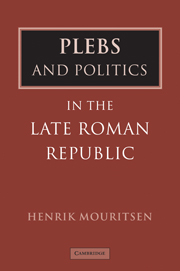Appendix. The ‘Lex Licinia de sodalitatibus’
Published online by Cambridge University Press: 22 September 2009
Summary
The Lex Licinia is central to the study of political participation in the late republic. It has attracted considerable debate and a range of different interpretations have been brought forward. It has been seen as a senatorial attempt to quash the political clubs of Clodius, an attempt to curb electoral malpractice among the elite, and as a combination of the two, targeting both ambitus and political violence in general.
The senate first issued a decree on these matters on the tenth of February 57 – a week after Clodius' supporters had given Pompey a serious heckling at the trial of Milo. According to Cicero the Senatus Consultum obliged the consuls: ‘ut sodalitates decuriatique discederent lexque de iis ferretur’, Q. Fr. 2.3.5. And a year later Crassus passed his Lex Licinia de sodalitatibus. There are several ancient references to the selection of judges prescribed in the law, Cic. Pis. 94; Phil. 1.20; Asc. 21C. But the most important source on the subject is Cicero's speech for Plancius.
Plancius was accused of bribery according to the Lex Licinia: ‘reus de sodaliciis petitus est lege Licinia, Schol. Bob. 152 (St)’. It is apparent that the law, for the first time, defined a crimen sodalicium: ‘quos tu si sodalis vocas, officiosam amicitiam nomine inquinas criminoso’, 46, and Plancius was formally prosecuted: ‘nomine legis Liciniae quae est de sodaliciis’, 36.
- Type
- Chapter
- Information
- Plebs and Politics in the Late Roman Republic , pp. 149 - 151Publisher: Cambridge University PressPrint publication year: 2001



